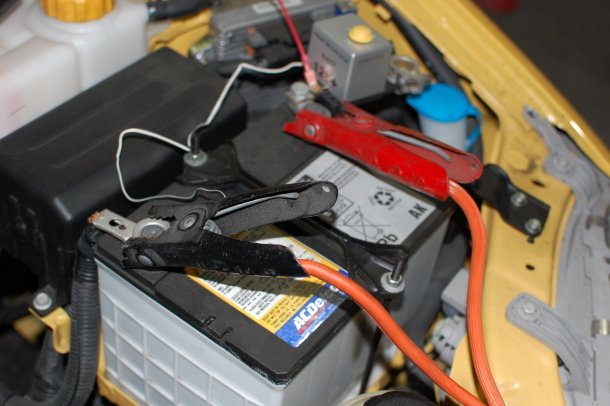Yes. Do not get "wrapped around the axle" over this. "Voltage" is electrical pressure just like pounds per square inch is pressure in a water pipe. A good, fully-charged battery will measure 12.6 volts, but just like you need higher water pressure from a water pump to force water to go up into a municipal water tower, you need higher voltage from your alternator to convince electrons to go into the plates of the battery so they can be stored there. All charging systems develop between 13.75 and 14.75 volts to do that.
Your charging pack needs a higher voltage because it relies on such a tiny capacity to get the job done. To put this in perspective, imagine there is fifty pounds of pressure in the water tower. The industrial-size water pump develops fifty five pounds of pressure, so some water will go up into the tower. If that pump were able to develop two hundred pounds, the tower would fill faster until it got so stressed, the top would blow off!
Now imagine if you had hand pump the size of a tire pump for a bicycle, and it was capable of developing one thousand pounds of pressure. The volume is so tiny, you could pump for the rest of your life, but never get the pressure in the water tower excessively-high. The pressure developed by the hand pump would be limited by the fact it cannot develop enough volume.
That is what is going to happen with your jumper pack. To say that a different way, you might measure its voltage to be seventeen volts or more, but as soon as it is plugged in, that voltage will get drawn down to the 12.6 volts of the vehicle's battery. The jumper pack will affect system voltage about as much as a tick affects the weight of an elephant.
The bigger issue to be concerned with is if this will even work with the cigarette lighter. There is actually two things to consider. The first is many lighter sockets are only live when the ignition switch is on. This is even more likely to be true with the newer "power outlets". If that is the case, the unit will charge normally while driving, but not when the engine is off. That part is just as well because you do not want to be draining the vehicle's battery to keep the jumper pack charged. The bigger issue is if the lighter socket is turned off, the jumper pack is not going to charge the vehicle's battery when it needs to in an emergency. You would have to turn the ignition switch on to turn the socket on, but then the jumper pack is going to be connected to the vehicle's fuel pump, heater fan, lights, and all the engine controls. It would die from exhaustion just like you would if you tried to supply your city's homes with water from that little tire pump.
The second concern you should be aware of is cigarette lighters have special contacts for the lighter element that include thermal safeguards. One of those is designed to short out if the lighter overheats and does not pop out. Shorting blows the fuse to protect the wiring. Many cell phone chargers, or in my case, a power inverter to run this laptop, have plugs that do not match the socket's contacts. If plugged in just right, they can short out and blow the fuse when there really is no actual defect.
My preference is to plug this unit into a power outlet that goes out when the ignition switch is off. On my 2014 Ram truck, the fuse for the power outlets has three terminals in the fuse box under the hood. The center terminal is common and is used all the time. You stick the fuse into one other terminal to have the outlet live all the time or you use the other terminal to have it live only when the ignition switch is on. This way you will need to unplug the jumper pack and connect it directly to the battery when it is needed.
The exception to this is if your jumper pack has a switch that must be turned on when charging the vehicle's battery. With that system, I would leave the power outlet live all the time. The jumper pack will charge from the vehicle, but if the vehicle's battery runs drained, the jumper pack will not. Important note: You cannot just switch it on and expect to start the engine. There is no way to get enough current through the socket's fuse that quickly. Instead, just turn the jumper pack on, then let it sit there for five to ten minutes. That will recharge the vehicle's battery at a slow enough rate to avoid blowing the socket's fuse, and the extended time will let the vehicle's battery absorb enough charge to crank the engine.
Wednesday, February 28th, 2018 AT 8:08 PM



